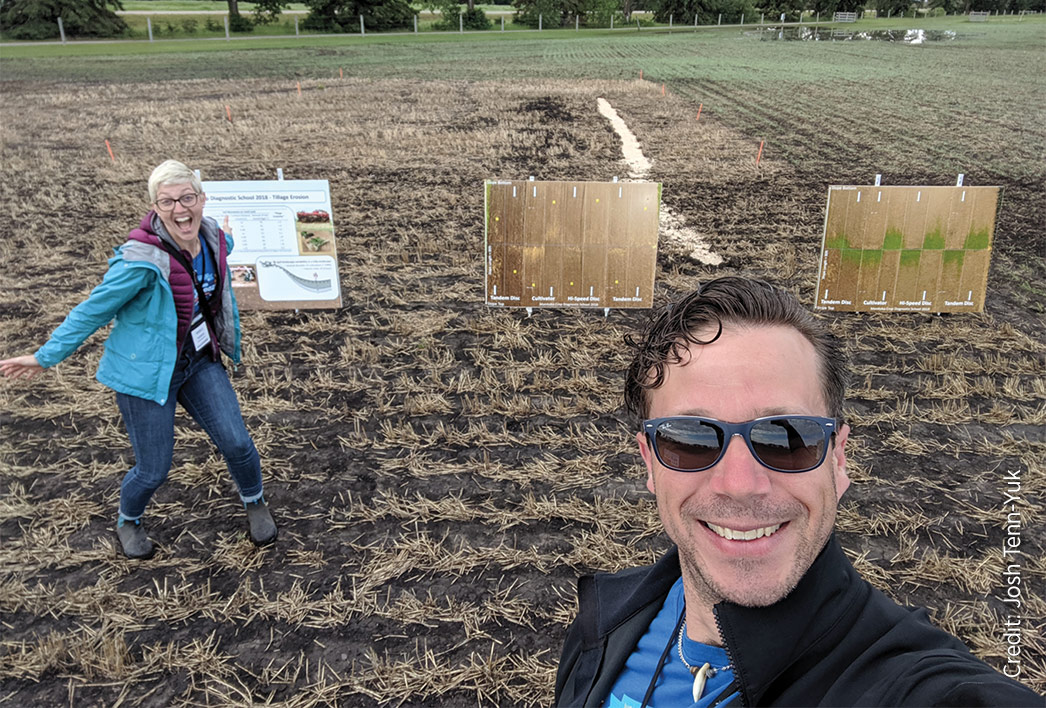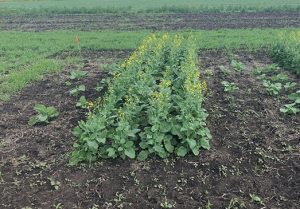Agronomy Insights
‘PALOOZA highlights
The Canola Council of Canada agronomy team worked with the provincial canola grower groups to organize canolaPALOOZA in Lacombe, Alberta; Sask CanolaPalooza in Saskatoon, Saskatchewan; and CROPS-A-PALOOZA in Carberry, Manitoba over the summer. These are important engagement events to share canola best management practices and priorities with farmers and agronomists in a field setting.
Autumn Barnes, CCC agronomy specialist, says the three events are a way to put grower-funded research into action. The goal is to share research results and practical applications with growers, agronomists, extension staff and other value chain representatives who attend. Here are a few highlights that can help with field work this fall and seed planning for 2020.
Use fall stubble counts to help set 2020 targets
While making seed plans for 2020, growers will want to figure out what plant densities are ideal for their farm and what percent of the seeds are likely to emerge, given field conditions. The Canola Council recommends targeting a plant density between 5-8 plants/ft2 and most growers can expect 50 to 60 per cent canola emergence, on average. The plant stand target is based on spring counts, but growers could make stubble counts this fall and compare that to this year’s seeding rates to see how many survived. This information could help growers make plans to hit their target for 2020. Use the Canola Calculator tools to run the numbers. For a conversation on plant establishment, listen to the Canola Watch “plant establishment” podcast with Murray Hartman, Rob Gulden and Darren Feitsma, recorded at canolaPALOOZA.
Is that tillage really necessary?
High-speed tillage tools can move more soil than the plow. Marla Riekman, soil management specialist with Manitoba Agriculture, says, “Lots of people think that these shallow units cause less erosion because they don’t run as deep and therefore they are sometimes thought of as ‘conservation tillage.’” But the amount of tillage erosion increases with both depth and speed, so as we see an increase in shallow high-speed tillage, we will see an increase in the rate of soil movement too, she says. Moving soil through tillage can erode topsoil on knolls and fill in drainage ditches on flat land. It also spreads herbicide-tolerant weed patches, clubroot and other pathogens that much faster. “My usual take-home message with tillage is to recognize the potential impact and use tillage more strategically,” Riekman says. “Don’t use the same implement on every acre every year, and think about your crop rotation. Consider when tillage is absolutely necessary and where you might be able to cut back.”

A case for combine weed-seed destroyers
Breanne Tidemann, research scientist with Agriculture and Agri-Food Canada, is looking at how the combine can be part of a farm integrated weed management (IWM) strategy. She is researching combine weed-seed destroyers, which include the Harrington Seed Destructor but also another Australian product called Seed Terminator and a Canadian alternative from Redekop. A weed-seed destroyer mounted on the combine puts all chaff through a cage mill. Any weed seeds in the chaff are destroyed. These crushers are not perfect because some weed seeds will shed their seed before harvest and some light and fluffy weed seeds, like thistles, don’t always enter the combine. But no IWM practice is perfect. When farmers employ a few of these imperfect tools, they can achieve long-term weed control that prevents herbicide-resistant weeds from taking hold and keeps yield loss to a minimum. For a conversation on weed management challenges and IWM practices, including weed-seed destroyers, listen to the Canola Watch “Weed Management” podcast with Tidemann, Bob Blackshaw and Ian Epp, recorded at canolaPALOOZA.
Fall banding to reduce seed-placed fertilizer

Canola is highly susceptible to seed-placed fertilizer, and the potential damage to seeds and seedlings is particularly high in dry spring soil conditions. The only fertilizer that should go in the seed row would be a starter rate of phosphorus (15 to 25 lb./ac. of actual phosphate), which can help get the seedlings going in cooler soil conditions and in soils with low baseline levels of phosphorus. ‘Palooza plots for 2019 showed quite clearly the stand-reducing effects of seed-placed nitrogen and of higher rates of seed-placed phosphorus. CCC agronomy specialist Warren Ward says, “Distribution of phosphate at rates below 15 lb./ac. becomes so variable that many plants will not benefit from having access to it, and risk of damage increases with rates higher than 25 lb./ac., especially under adverse conditions.”
Separation of seed and fertilizer can be a challenge with some drills, but crop nutrition specialists speaking at the ‘Paloozas encouraged growers to find a work-around – be it fall banding or new openers that improve separation and seed-bed utilization. For more on this discussion, listen to the Canola Watch “Fertility” podcast with Norm Flore, Dale Fedoruk, Patrick Mooleki and Warren Ward, recorded at canolaPALOOZA.
Seed treatments still work on flea beetles

Plots at ‘Paloozas clearly showed that current seed treatments work well to protect canola from flea beetles. The efficacy of seed treatments came into question this spring in areas where farmers had to spray some fields more than once to protect young seedlings from flea beetle hoards. It was a “perfect” year for flea beetles: hungry flea beetles took advantage of any warm temperatures and dry conditions, leaving the slow-growing crop extra vulnerable. So what will be the plan for next year? Some seed treatments do provide enhanced protection. Seeding in mid- or late May also seemed to reduce flea beetle damage in areas at highest risk. Growers could use the 2019 experience when planning seed treatments and seed timing for 2020. For more on flea beetles and other insects, listen to the Canola Watch “Insects” podcast with Hector Carcamo, James Tansey and Keith Gabert, recorded at canolaPALOOZA.
Register for Canola Discovery Forum
Canola Discovery Forum 2019 is November 13-14 at the RBC Convention Centre in Winnipeg. Canola Discovery Forum provides a unique opportunity for collaboration, consensus building and dialogue with the whole canola value chain. The target audience includes canola growers, researchers, life science representatives, regulators, equipment manufacturers, economists, climatologists, agronomists and extension specialists. The 2019 forum has an integrated pest management theme. For more information on the Canola Discovery Forum and to register, go here.





